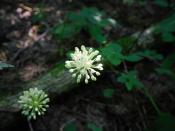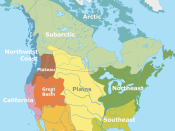Also known as wild leeks, ramps are members of the same family as garlic, scallions, and onions. Poking up through leaf litter on the forest floor, their green circles of sword-shaped leaves are among the first signs of spring in the region. Once the trees turn fully green and block the sun, the ramps go away for another year.
The vegetable's taste is described as an appetizing mixture of its kin: garlicky onion. The smell is what keeps some would-be connoisseurs at bay. It's pungent and can linger for days.
The smell oozes out of the pores of sweaty folk. In years past, schoolchildren who gorged on the spring veggies were often excused from classes for several days. "You can imagine in a one-room classroom--especially with little boys getting overheated--and what that smelled like," as Archaeologists have said.
Ramps are native to eastern North American mountains. The plants are found in moist deciduous (non-evergreen) forests as far north as Canada, as far south as North Carolina and Tennessee, and as far west as Missouri and Minnesota.
The first European settlers here are thought to have learned to eat ramps from Native Americans. Both groups presumably saw the herbs as a spring tonic rich in vitamins and minerals after a long winter without fresh vegetables.





